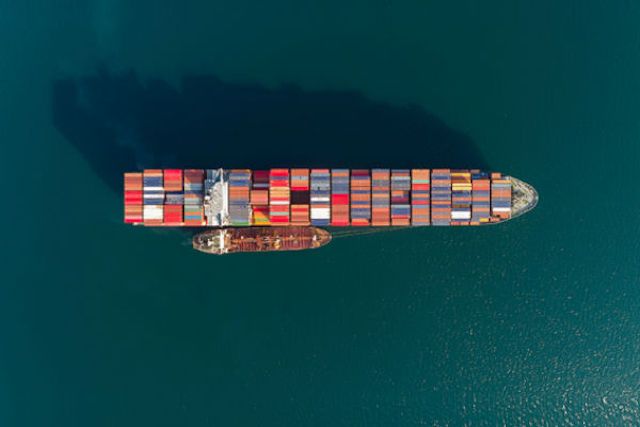
The government will convert 15% of all ships to eco-friendly ships by 2030. We will secure technology that can reduce greenhouse gas emissions by more than 70% compared to oil ships, and expand eco-friendly fuel supply infrastructure in stages.
According to the Ministry of Land, Infrastructure and Transport on the 23rd, the government confirmed the ‘1st Basic Plan for Eco-friendly Ships’ that contained the above contents through the ’23rd Central Emergency Economy Headquarters Meeting’ and the ‘7th Korean New Deal Ministers’ Meeting.
The worldwide shipbuilding and shipping markets are shifting the paradigm from oil ships to eco-friendly ship systems to respond to the strengthening of greenhouse gas regulations of the International Maritime Organization (IMO) and the implementation (planned) of the EU’s Emissions Trading System (EU-ETS).
Accordingly, the government also implemented the’Act on Promotion of Development and Distribution of Environment-Friendly Ships’ in order to actively respond to marine environment regulations and new eco-friendly ship markets, followed by this basic plan for eco-friendly ships.
The government predicted that through this basic plan, environmental improvement effects of 1.3 trillion won will occur by 2030. It is expected to reduce about 3,000 tons of fine dust in addition to measures to reduce PM10, along with about 400,000 tons of greenhouse gases.
528 vessels converted to eco-friendly ships… Production inducement effect 11兆
First, it was decided to preemptively convert from the public sector to eco-friendly ships by applying commercially available technologies such as LNG and hybrid, and spread it to the private sector.
The goal is to convert a total of 388 government ships into eco-friendly ships by 2030, such as replacing 199 old government ships and renovating 189 ships under 10 years old by installing a fine dust reduction device (DPF). In this process, it is expected that construction costs can be reduced by utilizing standard design and integrated orders.
In the case of civilian ships, support is provided to convert 58 internal vessels such as tanker, pilot and passenger vessels and 82 external vessels such as cargo vessels, a total of 140 vessels into eco-friendly vessels.

It plans to convert 528 ships, which is 15% of the 3,542 target ships, into eco-friendly ships. By 2030, it plans to create sales of 4,900 billion won, production induction effect of 11 trillion won, and employment effect of 40,000 people.
The government predicted that it will contribute to revitalizing regional economies such as Busan (1.5 trillion won), Jeonnam (1.2 trillion won), Ulsan (1 trillion won), and Gyeongnam (0.4 trillion won), where the shipbuilding and shipping industries are concentrated.
In order to promote the supply of eco-friendly ships, the infrastructure for supplying eco-friendly fuels such as LNG and electricity will be expanded in stages. We will diversify the means of supplying LNG fuel, such as operating LNG bunkering vessels and building onshore terminals.
The fuel supply infrastructure will also be expanded, such as using AMP, the onshore power supply device of the berth ship, as a fast charging facility for small electric/hybrid ships.

Construction of a roadmap for’Carbonless Ships’… Investment of 950 billion won by 2031
We also focus on developing leading technologies for future eco-friendly ships. It will localize and upgrade the technologies of liquefied natural gas (LNG), electricity, and hybrid core equipment, and build a roadmap that leads from low-carbon ship technologies such as mixed fuels to non-carbon ship technologies such as hydrogen and ammonia.
From 2022 to 2031, the government will invest about 950 billion won in the development of eco-friendly ship life cycle innovation technology. Through this, it is expected to secure technology that can reduce greenhouse gas emissions by more than 70% compared to oil ships by 2030.
‘Greenship-K’, a Korean-style demonstration project, is also promoted. After building and piloting small coastal ships with eco-friendly technology, if technology and economics are verified, it will expand to large ships and link them with land and sea verification and final commercialization.

It will also build more than 10 pilot ships, including LNG bunkering ships by 2022 and LNG-ammonia mixed fuel propulsion ships by 2025. A multi-purpose marine demonstration vessel will be built, and the government vessel scheduled to be retired will be renovated to construct a marine demonstration test bed for more than four equipment.
A national certification system for eco-friendly ships and equipment is also operated to create a market-led ecosystem for eco-friendly ships. When selecting a business operator, additional points will be given and international standardization of certified technologies will be supported.
Related Articles

Before the introduction of’IMO 2020’… “The biggest change in oil history”

Korea Gas Corporation signs LNG bunkering support project with KIAT

Gas Corporation succeeds in LNG shipment verification test between ships

Selected as a support company for the construction of LNG bunkering ships by KOGAS
Based on the operation information of eco-friendly ships, we will also establish a foundation for safe operation and management by establishing a support center that can analyze and verify greenhouse gas and air pollutant emissions, as well as remote diagnosis and predictive maintenance of ships.
A government official said, “The transition to eco-friendly ships is an inevitable obligation under international norms and a new challenge in the shipping and shipbuilding sectors, and will serve as an opportunity to advance the industrial ecosystem to the next level.” “We will actively support the shipbuilding and equipment industry sectors to take the lead in realizing carbon neutrality in 2050 and creating a sustainable industrial ecosystem, while developing into a new growth engine that leads a new era.”
